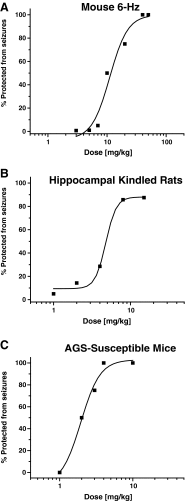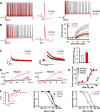The riluzole derivative 2-amino-6-trifluoromethylthio-benzothiazole (SKA-19), a mixed KCa2 activator and NaV blocker, is a potent novel anticonvulsant
- PMID: 25256961
- PMCID: PMC4322077
- DOI: 10.1007/s13311-014-0305-y
The riluzole derivative 2-amino-6-trifluoromethylthio-benzothiazole (SKA-19), a mixed KCa2 activator and NaV blocker, is a potent novel anticonvulsant
Abstract
Inhibitors of voltage-gated sodium channels (Na(v)) have been used as anticonvulsants since the 1940s, while potassium channel activators have only been investigated more recently. We here describe the discovery of 2-amino-6-trifluoromethylthio-benzothiazole (SKA-19), a thioanalog of riluzole, as a potent, novel anticonvulsant, which combines the two mechanisms. SKA-19 is a use-dependent NaV channel blocker and an activator of small-conductance Ca(2+)-activated K(+) channels. SKA-19 reduces action potential firing and increases medium afterhyperpolarization in CA1 pyramidal neurons in hippocampal slices. SKA-19 is orally bioavailable and shows activity in a broad range of rodent seizure models. SKA-19 protects against maximal electroshock-induced seizures in both rats (ED50 1.6 mg/kg i.p.; 2.3 mg/kg p.o.) and mice (ED50 4.3 mg/kg p.o.), and is also effective in the 6-Hz model in mice (ED50 12.2 mg/kg), Frings audiogenic seizure-susceptible mice (ED50 2.2 mg/kg), and the hippocampal kindled rat model of complex partial seizures (ED50 5.5 mg/kg). Toxicity tests for abnormal neurological status revealed a therapeutic index (TD50/ED50) of 6-9 following intraperitoneal and of 33 following oral administration. SKA-19 further reduced acute pain in the formalin pain model and raised allodynic threshold in a sciatic nerve ligation model. The anticonvulsant profile of SKA-19 is comparable to riluzole, which similarly affects Na(V) and KCa2 channels, except that SKA-19 has a ~4-fold greater duration of action owing to more prolonged brain levels. Based on these findings we propose that compounds combining KCa2 channel-activating and Na(v) channel-blocking activity exert broad-spectrum anticonvulsant and analgesic effects.
Figures








Similar articles
-
Riluzole and novel naphthalenyl substituted aminothiazole derivatives prevent acute neural excitotoxic injury in a rat model of temporal lobe epilepsy.Neuropharmacology. 2023 Feb 15;224:109349. doi: 10.1016/j.neuropharm.2022.109349. Epub 2022 Nov 24. Neuropharmacology. 2023. PMID: 36436594 Free PMC article.
-
S(+)-(2E)-N-(2-Hydroxypropyl)-3-Phenylprop-2-Enamide (KM-568): A Novel Cinnamamide Derivative with Anticonvulsant Activity in Animal Models of Seizures and Epilepsy.Int J Mol Sci. 2020 Jun 19;21(12):4372. doi: 10.3390/ijms21124372. Int J Mol Sci. 2020. PMID: 32575479 Free PMC article.
-
Characterization of the anticonvulsant properties of F-721.Epilepsy Res. 1993 May;15(1):35-45. doi: 10.1016/0920-1211(93)90007-t. Epilepsy Res. 1993. PMID: 8391982
-
Anticonvulsant profile of valrocemide (TV1901): a new antiepileptic drug.Epilepsia. 2001 Jul;42(7):831-6. doi: 10.1046/j.1528-1157.2001.042007831.x. Epilepsia. 2001. PMID: 11488880
-
Effects of Benzothiazolamines on Voltage-Gated Sodium Channels.Handb Exp Pharmacol. 2018;246:233-250. doi: 10.1007/164_2017_46. Handb Exp Pharmacol. 2018. PMID: 28939972 Review.
Cited by
-
Fluorine-containing substituents: metabolism of the α,α-difluoroethyl thioether motif.Beilstein J Org Chem. 2019 Jun 28;15:1441-1447. doi: 10.3762/bjoc.15.144. eCollection 2019. Beilstein J Org Chem. 2019. PMID: 31293694 Free PMC article.
-
Ca2+ signalling in fibroblasts and the therapeutic potential of KCa3.1 channel blockers in fibrotic diseases.Br J Pharmacol. 2020 Mar;177(5):1003-1024. doi: 10.1111/bph.14939. Epub 2020 Feb 3. Br J Pharmacol. 2020. PMID: 31758702 Free PMC article. Review.
-
Functional identification of activity-regulated, high-affinity glutamine transport in hippocampal neurons inhibited by riluzole.J Neurochem. 2017 Jul;142(1):29-40. doi: 10.1111/jnc.14046. Epub 2017 May 18. J Neurochem. 2017. PMID: 28423185 Free PMC article.
-
Is Targeting of Compensatory Ion Channel Gene Expression a Viable Therapeutic Strategy for Dravet Syndrome?Epilepsy Curr. 2019 May-Jun;19(3):193-195. doi: 10.1177/1535759719844780. Epub 2019 Apr 29. Epilepsy Curr. 2019. PMID: 31035820 Free PMC article.
-
The Trials and Tribulations of Structure Assisted Design of KCa Channel Activators.Front Pharmacol. 2019 Sep 20;10:972. doi: 10.3389/fphar.2019.00972. eCollection 2019. Front Pharmacol. 2019. PMID: 31616290 Free PMC article.
References
Publication types
MeSH terms
Substances
Grants and funding
LinkOut - more resources
Full Text Sources
Other Literature Sources
Medical
Molecular Biology Databases
Miscellaneous

